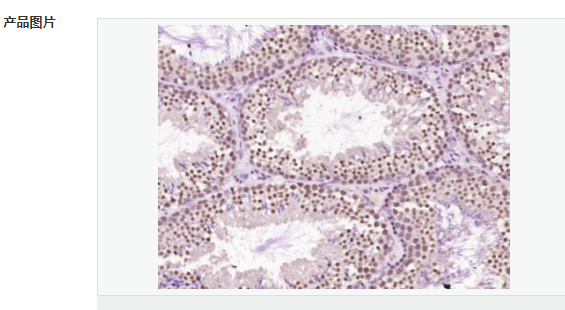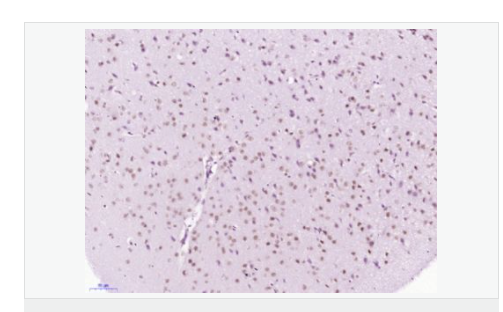

貨號
產(chǎn)品規(guī)格
售價
備注
BN41030R-100ul
100ul
¥2360.00
交叉反應(yīng):Mouse(predicted:Human,Rat,Dog,Pig,Cow,Horse) 推薦應(yīng)用:IHC-P,IHC-F,ICC,IF,ELISA
BN41030R-200ul
200ul
¥3490.00
交叉反應(yīng):Mouse(predicted:Human,Rat,Dog,Pig,Cow,Horse) 推薦應(yīng)用:IHC-P,IHC-F,ICC,IF,ELISA
產(chǎn)品描述
| 英文名稱 | PAPOG |
| 中文名稱 | 多聚合酶g抗體 |
| 別 名 | PAPOG_HUMAN; Poly(A) polymerase gamma; PAP-gamma; Neo-poly(A) polymerase; Neo-PAP; Polynucleotide adenylyltransferase gamma; SRP RNA 3'-adenylating enzyme. |
| 抗體來源 | Rabbit |
| 克隆類型 | Polyclonal |
| 交叉反應(yīng) | Mouse, (predicted: Human, Rat, Dog, Pig, Cow, Horse, ) |
| 產(chǎn)品應(yīng)用 | ELISA=1:5000-10000 IHC-P=1:100-500 IHC-F=1:100-500 ICC=1:100-500 IF=1:100-500 (石蠟切片需做抗原修復(fù)) not yet tested in other applications. optimal dilutions/concentrations should be determined by the end user. |
| 分 子 量 | 70kDa |
| 細胞定位 | 細胞核 |
| 性 狀 | Liquid |
| 濃 度 | 1mg/ml |
| 免 疫 原 | KLH conjugated synthetic peptide derived from human PAPOG:101-200/736 |
| 亞 型 | IgG |
| 純化方法 | affinity purified by Protein A |
| 儲 存 液 | 0.01M TBS(pH7.4) with 1% BSA, 0.03% Proclin300 and 50% Glycerol. |
| 保存條件 | Shipped at 4℃. Store at -20 °C for one year. Avoid repeated freeze/thaw cycles. |
| PubMed | PubMed |
| 產(chǎn)品介紹 | This gene encodes a member of the poly(A) polymerase family which catalyzes template-independent extension of the 3' end of a DNA/RNA strand. This enzyme shares 60% identity to the well characterized poly(A) polymerase II (PAPII) at the amino acid level. These two enzymes have similar organization of structural and functional domains. This enzyme is exclusively localized in the nucleus and exhibits both nonspecific and CPSF (cleavage and polyadenylation specificity factor)/AAUAAA-dependent polyadenylation activity. This gene is located on chromosome 2 in contrast to the PAPII gene, which is located on chromosome 14. [provided by RefSeq, Jul 2008]. Function: Polymerase that creates the 3'-poly(A) tail of mRNA's. Also required for the endoribonucleolytic cleavage reaction at some polyadenylation sites. May acquire specificity through interaction with a cleavage and polyadenylation specificity factor (CPSF) at its C-terminus. Subunit: Responsible for the post-transcriptional adenylation of the 3'-terminal of mRNA precursors and several small RNAs including signal recognition particle (SRP) RNA, nuclear 7SK RNA, U2 small nuclear RNA, and ribosomal 5S RNA. Subcellular Location: Nucleus. Tissue Specificity: Expressed predominantly in testis, and weakly in other tissues. Overexpressed in several tumors. Post-translational modifications: Polysumoylated. Varying sumolyation depending on tissue- and cell-type. Highly sumoylated in bladder and NIH 3T3 cells. Sumoylation is required for nuclear localization and enhances PAP stability. Desumoylated by SENP1. Inhibits polymerase activity. Hyperphosphorylation on multiple CDK2 consensus and non-consensus sites in the C-terminal Ser/Thr-rich region represses PAP activity in late M-phase. Phosphorylation/dephosphorylation may regulate the interaction between PAP and CPSF. Acetylated in the C-terminus. Acetylation decreases interaction with NUDT21 and KPNB1, and inhibits nuclear localization through inhibiting binding to the importin alpha/beta complex. Similarity: Belongs to the poly(A) polymerase family. SWISS: Q9BWT3 Gene ID: 64895 Database links: SwissProt:Q9BWT3 Important Note: This product as supplied is intended for research use only, not for use in human, therapeutic or diagnostic applications. |

